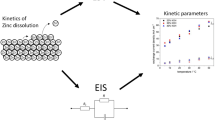Abstract
The effect of sparging on mass transfer is reported for zinc electrolytes containing antimony and antimony-free electrolytes. Comparative results with non-sparged electrolytes show, an enhancement in mass transfer. In the sparged electrolyte, the mass transfer coefficients,K Zn, increase with increasing current density, antimony additions, and sulphuric acid concentration. The deposition morphology is consistent with the mass transfer results. A relationship between the mass transfer coefficients for sparged and non-sparged systems is obtained. The relationship correlates satisfactorily with the data and provides a quantitative method for determining the degree of enhancement in mass transfer coefficients due to sparging. The correlation which best represents the mass transfer data for sparged zinc electrolytes is
whereSh, Re, andSc are the Sherwood, Reynolds, and Schmidt numbers, respectively. The correlation represents the case where sparging is applied to a gas evolving electrode, hydrogen in this case.
Similar content being viewed by others
References
W. R. Johnson and L. E. Pfister, The Fourth AES Continuous Strip Plating Symposium, American Electroplater's Society, Inc., Winter Park, FL, May (1985) Dl.
S. F. Chen, PhD Dissertation, University of Missouri-Rolla (1986) pp. 55–84.
L. Sigrist, O. Dossenbach, and N. Ibl,Int. J. Heat Mass Transfer 22 (1978) 1393–9.
G. H. Sedahmed,J. Appl. Electrochem. 15 (1985) 777.
H. Vogt, in Comprehensive Treatise of Electrochemistry’, Vol. 6 (edited by E. Yeager, J. O'M Bockris, B. E. Conway, and S. Sarangapani), Plenum Press, New York (1983) p. 445.
V. A. Ettel, B. V. Tilak, and A. S. Gendron,J. Electrochem. Soc. 121 (1974) 867.
G. H. Sedahmed, H. A. Farag, A. A. Zatout, and F. A. Katout,J. Appl. Electrochem. 16 (1986) 374.
G. H. Sedahmed and L. W. Schmilt,Can. J. Chem. Eng. 60 (1982) 767.
G. H. Sedahmed,J. Appl. Electrochem. 8 (1978) 399.
10 (1980) 351.
S. Mohanta and T. Z. Fahidy,7 (1977) 235.
J. R. Cuzmar, PhD Dissertation, University of Missouri-Rolla (1985) pp. 47–108.
L. J. J. Janssen and J. G. Hoogland,Electrochim. Acta 18 (1973) 543.
A. Y. Hosny, PhD Dissertation University of Missouri-Rolla (1987).
H. Vogt,Electrochim. Acta 23 (1978) 203.
R. Winand, Electrocrystallization, in ‘Application of Polarization Measurements in the Control of Metal Deposition’ (edited by I. H. Warren) Elsevier Science, Amsterdam, The Netherlands (1984) pp. 47–83.
E. W. Washburn, ‘International Critical Tables,’, McGraw-Hill, New York (1929) 65.
L. J. J. Janssen and J. G. Hoogland,Electrochim. Acta 15 (1970) 1013.
Author information
Authors and Affiliations
Rights and permissions
About this article
Cite this article
Hosny, A.Y., O'Keefe, T.J., Johnson, J.W. et al. Effect of gas sparging on mass transfer in zinc electrolytes. J Appl Electrochem 22, 596–605 (1992). https://doi.org/10.1007/BF01092607
Received:
Revised:
Issue Date:
DOI: https://doi.org/10.1007/BF01092607




